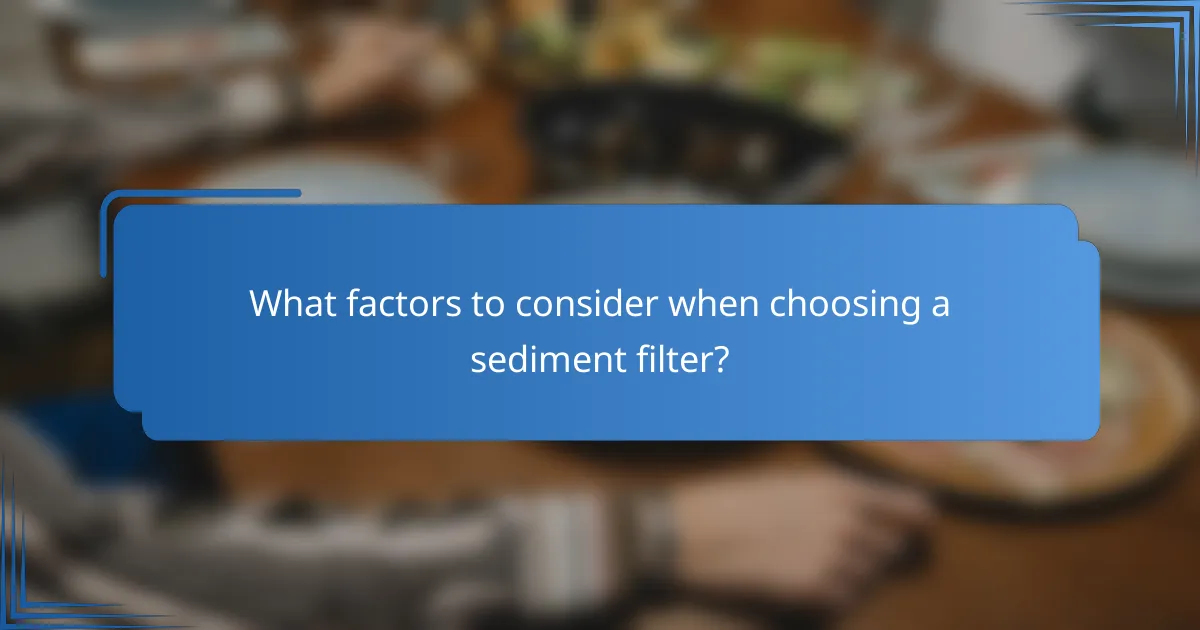Installing a sediment filter is a simple yet effective way to improve your home’s water quality by eliminating particulates. To ensure optimal performance, it is crucial to regularly clean or replace the filter, as this maintenance extends its lifespan and guarantees clean water for your household.

How to install a sediment filter in your home
Installing a sediment filter in your home is a straightforward process that enhances water quality by removing particulates. Proper installation ensures effective filtration and longevity of the system.
Step-by-step installation guide
Begin by turning off the main water supply to prevent leaks. Next, choose a suitable location for the filter, ideally near the water source. Cut the pipe where the filter will be installed, and attach the filter according to the manufacturer’s instructions.
Secure all connections with appropriate fittings and ensure there are no leaks. Once everything is in place, turn the water supply back on and check for proper operation.
Tools required for installation
For a successful installation, you will need a few basic tools. A pipe cutter or hacksaw is essential for cutting the plumbing, while adjustable wrenches will help tighten fittings securely.
Additionally, having Teflon tape on hand is useful for sealing threaded connections to prevent leaks. A bucket may also be handy to catch any residual water during the installation process.
Common installation mistakes
One common mistake is failing to turn off the water supply, which can lead to a messy situation. Another error is not properly aligning the filter, which can cause leaks or reduce effectiveness.
Ensure that all connections are tight and check for leaks after installation. Regularly monitoring the filter’s performance can help catch any issues early on.

How to clean a sediment filter effectively
Cleaning a sediment filter effectively involves removing accumulated debris to maintain optimal water flow and quality. Regular maintenance ensures the filter functions properly and extends its lifespan.
Recommended cleaning frequency
The cleaning frequency for a sediment filter typically ranges from every month to every three months, depending on water quality and usage. In areas with high sediment levels, more frequent cleaning may be necessary.
To determine the best schedule, monitor the filter’s performance and adjust based on the clarity of the water and flow rate. Keeping a log can help track when cleaning is needed.
Cleaning methods for different filter types
Different sediment filters require specific cleaning methods. For cartridge filters, rinsing under running water is often sufficient, while backwashing is suitable for sand filters.
Always refer to the manufacturer’s guidelines for the best cleaning practices. Some filters may need replacement instead of cleaning, especially if they show signs of wear or damage.
Signs that your filter needs cleaning
Common signs that a sediment filter needs cleaning include a noticeable decrease in water flow or an increase in sediment in the water. If the water appears cloudy or discolored, it’s time to check the filter.
Additionally, if you notice unusual odors or tastes in the water, it may indicate that the filter is overloaded and requires immediate attention. Regular monitoring will help you catch these issues early.

How to replace a sediment filter
Replacing a sediment filter is essential for maintaining clean water quality. Regular replacement ensures that the filter effectively removes impurities and extends the lifespan of your water system.
When to replace your sediment filter
Generally, sediment filters should be replaced every 6 to 12 months, depending on water quality and usage. Signs that it’s time for a replacement include reduced water flow, discoloration, or a noticeable change in taste or odor.
Monitoring your filter’s performance can help determine the best replacement schedule. If your home uses well water or has high sediment levels, consider replacing the filter more frequently.
Replacement process overview
To replace a sediment filter, start by turning off the water supply to prevent leaks. Next, remove the filter housing using a wrench if necessary, and take out the old filter.
Install the new filter by placing it in the housing, ensuring it fits snugly. Reassemble the housing, turn the water supply back on, and check for leaks. It’s advisable to run water through the new filter for a few minutes to flush out any loose particles.
Best sediment filter brands for replacements
Some of the most reputable brands for sediment filters include 3M, Pentair, and APEC. These brands offer a variety of filters suitable for different water systems and quality needs.
When selecting a replacement, consider filters that meet industry standards, such as NSF certification, which ensures safety and effectiveness. Reading customer reviews can also provide insights into performance and longevity.

How to monitor sediment filter lifespan
Monitoring sediment filter lifespan is essential for maintaining water quality and system efficiency. Regular checks can help determine when to clean or replace the filter, ensuring optimal performance and preventing system damage.
Indicators of filter lifespan
Several indicators can signal the need for filter maintenance. A noticeable decrease in water flow rate or increased sediment in the water can suggest that the filter is becoming clogged. Additionally, if you observe discoloration or unusual odors in the water, these may also indicate that the filter is nearing the end of its effective lifespan.
Routine visual inspections can help identify physical signs of wear or damage. If the filter appears dirty or has visible buildup, it may be time to clean or replace it.
Using pressure gauges for monitoring
Installing pressure gauges before and after the sediment filter can provide valuable data on its performance. A significant difference in pressure readings indicates that the filter is becoming clogged and may need maintenance. Generally, a pressure drop of around 5-10 psi can suggest that the filter should be cleaned or replaced.
Regularly checking these gauges allows for proactive maintenance, preventing unexpected system failures and ensuring consistent water quality.
Tracking filter usage and performance
Keeping a log of filter usage can help track performance over time. Note the installation date, cleaning dates, and any changes in water quality or flow rate. This information can help establish a maintenance schedule based on actual performance rather than arbitrary timeframes.
Consider using a calendar reminder or a simple spreadsheet to track these metrics. This practice can help you anticipate when to clean or replace the filter, ensuring that your water system operates efficiently.

What are the benefits of using a sediment filter?
Using a sediment filter provides significant advantages, including enhanced water quality and protection for plumbing systems. Regular installation and maintenance can lead to long-term savings and improved health outcomes.
Improved water quality
A sediment filter effectively removes particles such as sand, silt, and rust from water, resulting in cleaner and clearer drinking water. This filtration process not only enhances the taste but also reduces the risk of contaminants that can affect health.
To maintain optimal water quality, it’s essential to monitor the filter regularly and replace it as needed. Depending on water quality and usage, sediment filters may need changing every few months to ensure they function effectively.
Extended lifespan of plumbing fixtures
By trapping sediment and debris, a sediment filter helps prevent clogs and buildup in pipes and fixtures. This protection can significantly extend the lifespan of plumbing systems, reducing the frequency of repairs and replacements.
Homeowners should consider installing a sediment filter at the point of entry to their water supply. This proactive measure can save time and money by minimizing wear on faucets, water heaters, and other fixtures.
Cost savings on water-related repairs
Investing in a sediment filter can lead to substantial cost savings over time. By preventing sediment-related damage, homeowners can avoid expensive plumbing repairs and replacements, which can run into hundreds or thousands of dollars.
Regular maintenance of the filter is crucial to maximize these savings. Keeping a schedule for cleaning or replacing the filter can help ensure that plumbing systems remain in good condition, ultimately reducing overall water-related expenses.

What factors to consider when choosing a sediment filter?
When selecting a sediment filter, consider its size and capacity, material quality, and compatibility with your existing plumbing. These factors will ensure effective filtration, durability, and ease of installation.
Filter size and capacity
The size and capacity of a sediment filter are crucial for its performance. Filters come in various sizes, typically ranging from 10 to 20 inches in length, and should match your water flow requirements. A filter with a higher capacity can handle larger volumes of water, making it suitable for households with multiple users.
To determine the right size, assess your water usage and flow rate. For example, a household with a high demand for water may benefit from a larger filter that can maintain pressure and efficiency over time.
Material and construction quality
The material and construction quality of a sediment filter directly affect its lifespan and effectiveness. Common materials include polypropylene, stainless steel, and fiberglass, each offering different levels of durability and filtration efficiency. Look for filters that meet industry standards for quality and performance.
High-quality filters often feature multi-layer designs that enhance filtration capabilities. Investing in a well-constructed filter can reduce the frequency of replacements and maintenance, ultimately saving you money in the long run.
Compatibility with existing plumbing
Ensuring compatibility with your existing plumbing is essential for a successful installation of a sediment filter. Check the size of your pipes and the filter’s inlet and outlet connections to avoid any mismatches. Most residential plumbing uses standard sizes, but it’s important to confirm before purchasing.
Additionally, consider the filter’s placement within your plumbing system. Installing it at the point of entry can provide comprehensive protection for your entire water supply, while under-sink options may be better for specific applications. Always consult a professional if you’re unsure about compatibility or installation requirements.
